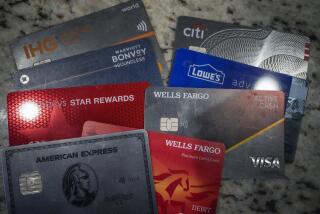It’s Not Too Late for Savers to Get a Good Yield
- Share via
Interest rates in general are down this year with the slowing economy. But yield-hungry savers who think they’ve missed the boat on peak rates may be pleasantly surprised to learn what’s still available.
If you look only at short-term U.S. Treasury bill yields, you might assume it’s long past time to lock in a good rate. The yield on six-month T-bills, for example, has fallen from 6.44% in mid-February to 5.97% now, back to last November’s levels.
But the average yield on six-month certificates of deposit at California banks and S&Ls; has risen from 4.98% in mid-February to 5.11% now, according to rate tracker Bradshaw Financial Network in Issaquah, Wash.
Nationally, the average six-month CD yield is 5.02% now, up from 4.76% in mid-February.
A buyer of a one-year Treasury bill, meanwhile, would have gotten a 6.83% yield in mid-February. Today a one-year T-bill yields just 6.14%. In contrast, the average yield on one-year California bank CDs has slipped only marginally, from 6.07% in mid-February to 5.92% now.
Why are T-bill and CD yields seemingly on different tracks this year? One reason is that CD yields, which are set arbitrarily by banks and S&Ls;, typically lag increases in T-bill yields, which are a function of market dynamics.
*
While T-bill yields surged last year as the Federal Reserve Board tightened credit repeatedly, CD yields were constantly playing catch-up. That has continued this year, even as T-bills have begun to ratchet lower.
But technical factors are also at work in the market this year. Though there’s no question the U.S. economy has slowed--putting downward pressure on market interest rates--short-term T-bill yields have fallen more than expected in part because of the dollar’s woes.
As the world’s central banks have bought dollars in an attempt to boost the anemic currency’s value, they have then turned around and invested many of those dollars in U.S. T-bills, essentially parking the money for now.
In particular, “There’s been huge investment by the Bank of Japan in the short-term part of the Treasury market,” says David Jones, economist at bond dealer Aubrey G. Lanston & Co. in New York.
At the same time, many large U.S. investors, unsure whether the next big move in interest rates will be up or down, have opted to stash cash in T-bills until the trend in rates becomes clearer. As a result, “We’ve been competing with the central banks” for short-term U.S. government securities, says David Rosenberg, portfolio manager at the Oppenheimer mutual funds in New York.
T-bill yields have now dropped so far, however, that many Wall Streeters think they’re absurdly low. Consider: The Fed is keeping the overnight lending rate among banks (the “federal funds” rate) at about 6%. Yet three-month T-bill yields are at 5.76%--or nearly a quarter-point under the shortest short-term interest rate.
Any number of events could cause T-bill yields to rebound this spring, economists say: The dollar-recycling by central banks could end; economic statistics could begin pointing to renewed strength; or inflation pressures could continue to rise. “We’ve had some disturbing early-warning indications on inflation,” notes Irwin Kellner, economist at Chemical Bank in New York. Gold and silver prices, for instance, have been remarkably strong this spring.
The only thing that could drive short-term rates sharply lower, on the other hand, would be convincing evidence that the U.S. is headed for recession. And that still seems a long shot.
So what’s the best strategy for savers? Be content to keep the “cash” portion of your portfolio in relatively short-term accounts, like six-month CDs, many experts say. If you have at least $10,000 in savings, consider buying T-bills directly from the Fed rather than buying CDs. At 5.97% currently, six-month T-bills pay nearly a full point more than the average six-month CD--and T-bill interest is exempt from state income tax.
If you want immediate access to your cash, keeping all or part of it in a money market mutual fund may be the smartest idea of all. Money fund yields average 5.5%, which is better than most six-month CD yields. And as fund managers slowly lengthen their portfolio maturities, they can boost yields even if market rates stay flat.
(BEGIN TEXT OF INFOBOX / INFOGRAPHIC)
Rates: A Mixed Bag
Short-turm Treasury bill yields have slumped since mid-February, but average rates on CDs at California banks and S&Ls; are higher or off marginally, depending on the term. Six-month T-bill:
Thursday: 5.9%
Feb. 13: 6.44% Six-month CD*:
Thursday: 5.11%
Feb. 13: 4.98% One-year CD*
Thursday: 5.92%
Feb. 13: 6.07%
* Average yields among California institutions.
Source: Bradshaw Finanical Network
More to Read
Inside the business of entertainment
The Wide Shot brings you news, analysis and insights on everything from streaming wars to production — and what it all means for the future.
You may occasionally receive promotional content from the Los Angeles Times.










